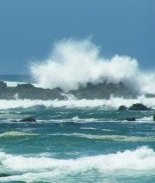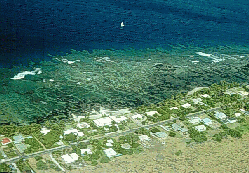Mangrove Zones
 Different mangrove species have different requirements. Some are more tolerant of salt than others. They have different nutrition needs. The plants are affected by wave energy, soil oxygen levels, and drainage. When a species finds its preferred conditions, it becomes stronger and more plentiful than others. This has led to quite clear zones among mangroves.
Different mangrove species have different requirements. Some are more tolerant of salt than others. They have different nutrition needs. The plants are affected by wave energy, soil oxygen levels, and drainage. When a species finds its preferred conditions, it becomes stronger and more plentiful than others. This has led to quite clear zones among mangroves.The zones run parallel to the shore or to the banks of tidal creeks:
Along the sea side, there is generally an area of grey mangroves, best adapted to a wide range of soil conditions. It is a tough species, and is Australia's most common mangrove due to its ability to tolerate low temperatures and a variety of other intertidal conditions. It is generally the first to start growing on new mud banks, with its distinctive peg roots. The Mangrove apple often grows in this zone too.
The red mangrove, also known as the stilt or spider mangrove, is usually found behind this zone where its long prop roots anchor it in wind and waves.
The next zone is the part that is flooded only sometimes, at times of very high tides. The soil is firmer but saltier because of the irregular flooding: the water evaporates and leaves a coating of salt which does not get diluted until the next flooding. The yellow mangrove species are found in this zone. Conditions make it difficult for other species to survive here, other than saltmarshes or succulent plants.
Further zones can see the grey mangrove again, and in less salty soil there may be a thick forest of the orange mangrove species.
Local conditions dictate what is found on the land side. For example, in tropical areas there may be regular flooding and freshwater swamps with less salt tolerant plants. There may be a zone of paperbark swamps as vegetation merges into rainforest. In areas seasonal rainfall, evaporation could mean increased saltiness, so there may be a saltmarsh.
The richest mangrove communities are found in tropical and sub-tropical areas where the water temperature is over 24ºC in the warmest month, where the annual rainfall is more than 1250mm and high mountains are close to the coast, ensuring rainfall.
Mangroves need protection from high energy waves which erode the shore and prevent seedlings from becoming established.
Salt
Many mangroves stop much of the salt from entering their systems by filtering it out through their roots. Some species can keep out more than 90% of salt in sea water. Others quickly pass the salt out of their systems once it has entered. Their leaves have special salt glands which pass the salt out. You can see and taste the salt coating the leaves. Still others collect the salt in bark or in older leaves that are about to drop. Some mangroves use more than one of these methods.
Mangroves also have features that conserve water: thick waxy leaves, fleshy leaves, pores in the leaves that are sunken below the surface so that wind doesn't dry them out.
Do mangroves need salt?
Apparently not. Some species have been kept in pots where they have grown healthily and flowered regularly when given only fresh water. However, experiments have shown that the best growth occurs where the plants live in sea water diluted by about 50 per cent with fresh water.
Unstable Ground
Apart from the salt, mangroves also have to cope with being water-logged, and with unstable soils that may be lacking in oxygen. Mangrove plants have come up with quite similar ways of dealing with these difficulties:
Roots
Roots support a plant and take in essential nutrients and oxygen. In unstable soil an extensive root system is necessary in order for the trees to remain standing. Most mangroves have more of the plant below the ground than above it. The main mass of roots, however, is generally within the top two metres of the soil, as the oxygen supply is in that layer. Cable roots and anchor roots provide support. Small roots come from these to collect nutients from the rich surface soil. Other roots collect oxygen from the soil.
Because little oxygen is in the mud, many mangroves raise part of their roots above the surface. These roots are covered in special breathing cells to draw in air. To avoid getting buried in the build up of soil sediment, the breathing roots can grow up vertically. Pollution is a problem : oil blocks the breathing cells and the plant can suffocate.
Red, stilt or spider, mangrove is subjected to high wave action and has stilt or prop roots. These spread far and wide, providing numerous anchors for the tree as well as a large surface area for the breathing cells. Extra stilts can grow from the branches or trunk, and develop many breathing cells as soon as they reach the mud.
Grey mangrove grows peg roots, which act like snorkels. Orange mangrove develops cable roots which have grown above the surface of the mud and then down into it again. Looking glass mangrove has buttress roots which are like flattened, blade-like stilt roots.
Spreading new plants
 The fruits and seedlings of all mangrove plants can float, which is how the plant sends its seeds away to grow in another area. Generally the seeds float away and lodge in mud, where they begin to grow. Some kinds will only germinate when temperatures or salt levels are satisfactory. Some species do not drop their seeds, but begin to grow out of the base of the fruits to form long spear-shaped stems and roots that grow, attached to the parent tree, for one to three years. They reach lengths of up to a metre before breaking off the parent plant and falling into the sea. They float horizontally until they can lodge in mud in a less salty place, where they turn vertically , roots down and buds up. They then begin to grow rapidly.
The fruits and seedlings of all mangrove plants can float, which is how the plant sends its seeds away to grow in another area. Generally the seeds float away and lodge in mud, where they begin to grow. Some kinds will only germinate when temperatures or salt levels are satisfactory. Some species do not drop their seeds, but begin to grow out of the base of the fruits to form long spear-shaped stems and roots that grow, attached to the parent tree, for one to three years. They reach lengths of up to a metre before breaking off the parent plant and falling into the sea. They float horizontally until they can lodge in mud in a less salty place, where they turn vertically , roots down and buds up. They then begin to grow rapidly.The cannonball mangrove produces a large fruit, about 20cm in diameter containing up to 18 tightly packed seeds. When ripe, it explodes and scatters the seeds, which float away on the sea. The seed of the looking-glass mangrove has a prominent ridge on one side. This can act as a sail when the seed is in the water. (source ... >>)























